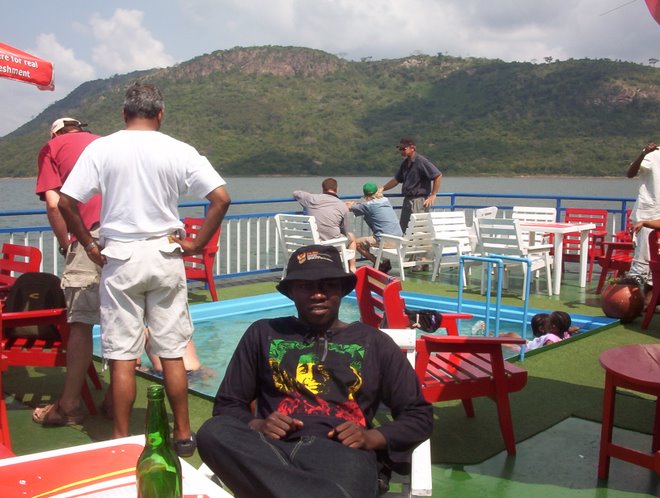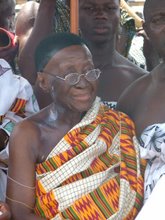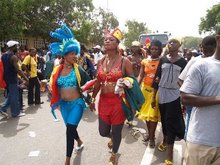GHANA
THE CHAINSAW MENACE IN GHANA: WHY ARE THE CHAINSAW OPERATORS NOT RETREATING
BY ENOCH DARFAH FRIMPONG, DAILY GRAPHIC
The forest resources of Ghana, which covered over 8 million hectares at the turn of the 20th century in the High Forest Zone (HFZ) have been decimated to less than 1.63 million hectares to date.
The causative factors, which have led to this sad state of affairs among others, include clearance for agriculture, wildfires, charcoal production, surface mining and more recently chainsawing and uncontrolled logging.
It is noted that, out of 2.7 million cubic meters of timber, which is harvested annually from the forests, illegal chainsaw operations alone account for 1.5 million cubic meters (MLF, 2003).
It follows from the above that chainsaw activities play a significant role in the declining of our forest resources.
In fact, the activities of chainsaw operators in the forests pose a myriad of problems that appear difficult to solve.
Most of the perpetrators are valiant, and undoubtedly the Forestry Commission (FC) staffs are beset with difficulties, which make them unequal to the task of curbing the menace of chainsaw operations.
Some of these chainsaw operators operate deep in the night and since they are usually armed to the teeth the FC staff sometimes have no option than to look on helplessly for the perpetrators to grab their booty with impunity.
The application of laws to bring the situation under control has been fraught with difficulties, which have had implications socially, politically, economically and environmentally.
No matter how one looks at it the problem still exists and the perpetrators are in serious business.
It is therefore prudent that the chainsaw menace is discussed dispassionately to let future resource managers know of the threats on the ground and also offer the opportunity for others to contribute their quota for a common solution.
It is on record that out of the total reserved area of (1.6 million hectares) in the High Forest Zone (HFZ) only 719,300 hectares (45percent) has been designated as Production forests from which timber could be harvested.
The rest are either under Permanent Protection or Temporary Protection (Convalescence) whilst the much degraded portions have been earmarked for conversion to Forest Plantations.
Protection areas as the name suggests are areas set aside to cater for biodiversity conservation, watershed management and it must be mentioned that illegal chainsaw operations are not limited only to Production areas but also in the Protection areas.
The Ashanti Regional Forestry Manager, Mr Attah Owusu, in a recent presentation on the chain saw menace to the Renewable Natural Resources Students Association 21st celebrations in Kumasi stated that within a period of 13years (1988-2002), the effective area under timber production had reduced from about 1.2 million hectares to approximately 719,300 hectares (58percent) with corresponding reduction in stock value from 14,435m3/km2 (based on 66 species) to 13,731m3/km2 (based on 82 species).
The reasons for the reduction, he said were attributable to annual wildfires, the chainsaw menace, and illegal logging, among others and added that there was loss of desirable economic species due to creaming of targeted species by chainsaw operators and illegal loggers.
According to him until 1980, chainsaw machines were only used to fell and crosscut trees into logs. However, when their use shifted to the production of lumber for commercial purpose, which intensified in the late 1980s, the government was compelled to legalise chainsaw operations with the promulgation of the Trees and Timber (chainsaw operations) Regulation 1991 (L.I. 1518).
This law required District Assemblies (DAs) to register chainsaw machines and permits acquired for felling and sawing trees by applying through the then District Forestry Officer to the District Assembly.
Upon receipt of the application the District Assembly (DA) then directed the District Forestry Officer (DFO) to conduct inspection and submit his recommendations to the DA.
The DA, upon receipt of the recommendation then directed the DFO to issue a permit for a fee fixed by resolution of the DA.
The idea, Mr Owusu said was to help alleviate the problem of wood requirements for roofing and other purposes especially in the rural areas where there were no mills.
In the end, however, the purpose was defeated since the then Forestry Department did not have sufficient staff to monitor the operations and this led to a lot of abuse.
He said the DAs could either not assist in monitoring and even in some cases some of the then District Secretaries issued permits directly to the applicants.
Another weakness was the fact that the Lands Department was handling trees in the off-reserve areas.
According to Mr Attah Owusu as a result of that, the L.I. 1518 was revoked by Section 42 of the Timber Resources Management Regulations 1998 (L.I. 1649), since prime species were being creamed, permits being photocopied and used several times.
Besides, he said barons in the cities, who were the main sponsors of the chainsaw operations, directed the products to the cities as destination points thereby depriving the rural folks of lumber supply. He added that there was also a lot of wastage as recovery was very low usually less than 20% as undersized trees were being felled.
The operators defaulted payment of royalty, rent and other taxes.
Because section 31 (1) of the Timber Resources Management Regulations 1998, LI 1649 only talks about prohibition of use of chainsaw to convert timber into lumber for sale, there appears to be a grey area because the question is what if the lumber so produced with chainsaw is neither sold nor exchanged nor used for any commercial purpose?
The law states that, (1) “No person shall use a chainsaw whether registered or unregistered to convert timber into lumber or other products for sale, exchange or any commercial purpose” and that (2) “No person shall sell or buy timber products to which (1) applies’’.
The question that arises is ,if a permit is say issued for a tree meant for community project, can a chainsaw be used in processing it or not?
Again Section 34 of L.I. 1649 says “No land owner shall permit any person to use an unregistered chainsaw for felling a tree or sawing timber on his land”.
If the land owner defaults he/she is sanctioned under Section 41(1) h.
So does it mean if the chainsaw is registered the land owner should allow sawing?
In accordance with Section 36 of L.I. 1649, the then Minister of Lands and Forestry directed that all milling companies should supply 20 percent of their lumber production to the domestic market as part of a government policy to address the supply of lumber to the local market.
Also in the Kumasi area alone 27 selected mills were granted Timber Utilization Permits (TUP) to supply their products (100 percent) to the local market but why are the millers not supplying the local market?
A number of reasons such as the increase in illegal chainsaw operations attributed to high cost of timber products from sawmills compared with the price of chainsawn products.
Sawmillers pay taxes and stumpage fees and their overhead costs are relatively higher.
They therefore sell at higher prices, which local consumers cannot afford.
Again sawmillers prefer to export their products to enable them get back their investment cost and it is on record that whereas export prices average US $95 (about ¢870,000) per cubic meter of log, the same amount fetches only between ¢35,000 and ¢45,000 on the local market.
Besides most of the selected mills are not active and the active ones usually complain about quota allocation while some of the Timber Utilization Permit (TUP) holders prefer to sell the raw materials to the bigger companies instead of processing for the local market.
Some claim their TUPs are not stocked with the desired species and that it could be argued that the export of lumber products by the sawmills has left a yawning gap on the local market, which the illegal chainsaw operators conveniently fill, eventually gaining monopoly.
This probably may be one of the causative factors why the chainsaw operators are not retreating. Chainsawing is a very quick way of making money. The law enforcing agencies are usually unco-operative. Operators usually operate deep in the night. They are most of the time armed to the teeth whereas FC staff are not armed. They convey their booty through unapproved routes to avoid detection by FC staff and Security Personnel. Farmers prefer to release trees on their farms to Chainsaw Operators rather than Loggers because of the relatively lower extraction damage to their farms. Court fines are ridiculously low and undeterrent. The unwillingness of the judiciary to apply the law is quite disturbing. For instance, though Section 17(3) of the Timber Resources Management Act, 1997 (Act 547) and its subsequent amendment, Timber Resources Management (Amendment) Act, 2002 (Act 617) prescribe “the confiscation to the state any tool, equipment and machinery used in the commission of timber related offences (including chainsawing)” the courts always release the vehicles involved to their owners.
For example, according to Mr Attah Owusu, the Regional Forestry Manager, in the Ashanti Region alone, from 2002 to date 37 vehicles involved in timber offences were all released to their owners by the courts.
Revelations in the print and electronic media in recent times and casual observation around the country in general and Kumasi in particular reveal that there is proliferation of retail outlets of chainsawn lumber.
Notorious places like the Timber markets in Accra and Takoradi, Anloga and Ehwiaa in Kumasi, Techiman and Agona Swedru could be cited.
The situation became so disturbing such that the Forestry Commission had no option than to intensify its monitoring system within its limited resources.
There were however, frequent instances where personnel of the Forestry Commission and other collaborators were brutalized by valiant chainsaw operators and this led to the Government’s intervention by institutionalising, Regional Timber Task Forces comprising the Military, Police and staff of the FC to help stem the tide.
Even though some successes have been chalked the cost incurred cannot be overlooked.
The activities of illegal chainsaw operators and the unflinching attempts by the FC to stem the tide have incurred inevitable costs, mainly, threat to human lives, loss of man-hours, social costs, economic costs and environmental costs
At Bekwai, one Range Supervisor lost his life when chasing a truck loaded with chain sawn lumber in 2002. Again at Goaso, it was recently reported that an Assistant District Manager was beaten mercilessly.
At Nkawie in the Atwima District, it was also reported that the right hand of a volunteer who had joined the FC staff to evacuate illegal lumber was amputated as a result of gun shot wounds he sustained from an attack by chain saw operators.
Loss of Man-hours
A lot of time is spent tracking and chasing chainsaw operators by personnel, resulting in the loss of man-hours and causing the FC to lose focus on its core functions
Management of the FC spends a lot of time discussing, strategising and implementing strategies to keep the menace in check
In prosecution of court cases for instance, Mr Owusu said from July 2002, to October 2003, 24 cases had been dealt with in court and that one particular case was adjourned 19 times, and in all these instances FC staff had to attend.
Recounting social costs Mr Owusu mentioned the destruction of sacred groves thereby provoking ancestral spirits, negative public image of the FC as the public view the FC as having lost control over the management of the forest resources, Chiefs in whose communities chainsaw activities occur lose their credibility as they are perceived to be conniving with the operators
On economic costs too, Mr Owusu said there was high cost of forest rehabilitation and that cost of monitoring chainsaw activities stands at about Euros 160,000,000 a year to the FC in Ashanti Region alone.
He said studies undertaken by the TIDD revealed an excess 1.7 million m3 of wood over the AAC of 2 million m3 which is equivalent to 1.2 million US dollars.
On environmental costs, he said there was loss of biodiversity, destruction of wildlife habitats, drying up of aquifers and water bodies.
In trying to move forward companies which were issued special permits to supply the local market but failed to do so should be sanctioned while there should be a design of wood friendly houses to reduce the use of wood in building, encourage the use of plastic and bamboo as substitutes to wood panelling and doors.
Since the ban on chainsaw operations is not working, policy makers should ensure that the laws are enforced while education on the ill effects of chainsaw operations intensified by the media and the FC especially around the Forest Fringe Communities
The chiefs and rural communities should be given sustainable incentives and livelihoods so as to refrain from colluding with the perpetrators.
Chainsaw operators and small scale wood users should form recognisable associations which could be allocated small concessions for utilisation under strict monitoring
The Renewable Natural Resources Students Association (RENARSA) and other student groups could take up the challenge in the education of the Citizenry on the toll the chainsaw menace is having on the country
And that to help ensure maximum utilisation of wood harvested, students could initiate research into how the ‘off cuts’ could be fully utilised without abuse
Chainsaw lumbering is a major contributor to the fast depletion of timber in the country and a serious environmental threat.
Abating it is however, difficult since it is a reliable source of lumber supply to the local market and since issues on chainsaw lumbering are quite delicate there is the need to have regular discussions among the various stakeholders to arrive at an acceptable consensus.
END







































